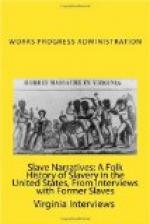8. Community and religious activities—Ward Chapel on West Sixth.
9. Description of informant—Gray hair, height 5 ft. 9 in., high cheekbones. Gray hair—practically straight says like father.
10. Other points gained in interview—Says father was part Irish. Belonged to Bill Boyd. Stayed there for years after freedom.
Name of Interviewer: Irene Robertson Subject: EX-SLAVE—HISTORY—OLD SAYINGS
This information given by: George Braddox
Place of Residence: Hazen, Arkansas
Occupation: Farmer age:
80
[TR: Information moved from bottom of first page.]
George Braddox was born a slave but his mother being freed when he was eipht years old they went to themselves—George had one sister and one brother. He doesn’t know anything about them but thinks they are dead as he is the youngest of the three. His father’s name was Peter Calloway He went with Gus Taylor to the war and never came back to his family. George said he had been to Chicago several times to see his father where he was living. But his mother let her children go by that name. She gave them a name Braddox when they were freed. Calloways lived on a joining plantation to John and Dave Gemes. John Gemes was the old master and Dave the young. George said they were mean to him. He can remember that Gus Taylor wes overseer for the Gemes till he went to war. The Gemes lived in a brick house and the slaves lived in log houses. They had a big farm and raised cotton and corn. The cotton was six feet tall and had big leaves. They had to pull the leaves to let the bowls get the sun to open. They topped the cotton too. They made lots of cotton and corn to an acre. Dave Gemes had several children when George moved away, their names were Ruben, John, Margaret, Susie and Betty. They went to school at Marshall, Texas.
John Gemes had fine carriages, horses and mules. He had one old slave who just milked and churned. She didn’t do anything else. When young calves had to be attended to somebody else had to help her and one man did all the feeding. They had lots of peafowles, ducks, geese and chickens.
They had mixed stock of chickens and guineas—always had a drove of turkeys. Sometimes the turkeys would go off with wild turkeys. There were wild hogs and turkeys in the woods. George never learned to read or write. He remembers they built a school for white children on the Calloway place joining the Gemes place but he thought it was tuition school. George said he thought the Gemes and all his “kin” folks came from Alabama to Texas, but he is not sure but he does know this. Dr. Hazen came from Tennessee to Texas and back to Hazen, Arkansas and settled. His cousin Jane Hodge (colored) was working out near here and he came here to deer hunt and just stayed with them. He said deer was plentiful here. It was not cleared and so close to White Cache, St. Francis and Mississippi rivers.




